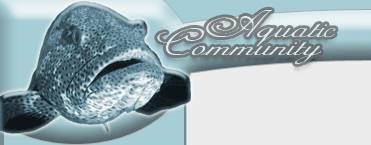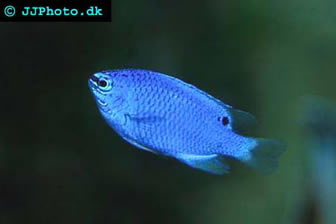Blue Devil
Chrysiptera cyanea is known under many different common names in English, such as Blue Devil, Blue Devil Damsel, Sapphire devil, Cornflower Sergeant-major, Cornflower Sergeantmajor, Red Tail Australian Damsel, Sky-blue Damsel, Blue Damsel, Blue Damselfish, and Orangetail Blue Damselfish.
Chrysiptera cyanea has not been evaluated for the IUCN Red List of Threatened Species.
Geographical range, habitat and habits
The Blue Devil inhabits the Indo-West Pacific. Its range stretches from the eastern edge of the Indian Ocean and Western Australia to New Guinea, New Britain, Solomon Islands, Marianas and Caroline Islands, Indonesia, Philippines, Taiwan and Ryukyu Islands. Southwards, it can be encountered down to Vanuatu, New Caledonia, Samoa, and Palau and Yap in Micronesia.
The Blue Devil is a reef associated species that lives among rubble and corals in clear sheltered lagoons and subtidal reef flats. Its depth range is 0-10 meters / 0-33 feet and it forms groups consisting of one adult male fish and several females or juveniles. When it feels scared, this fish will hide inside a hole or crevice and change its colour until it becomes almost completely black. One it feels safe again, it will rapidly change back into its normal colouration.
Size and appearance
The largest scientifically measured Blue Devil was 8.5 cm / 3.3 in.
Just as the name suggests, the Blue Devil is a brilliantly coloured light-blue fish. Juveniles and females normally sport a small black spot at the rear base of the dorsal fin and will typically not have any yellow markings. The adult male will on the other hand have a bright yellow or orange snout and tail and no black spot. (Please note that some females never develop any black spot.)
As mentioned above, the Blue Devil can temporarily change colour when it needs to stay hidden.
Blue Devil care
The Blue Devil is a very hardy marine species that can be recommended for novice saltwater aquarists. Due to its sturdiness it is commonly used to cycle new aquariums, but you should keep in mind that adding this fish as the first inhabitant of an aquarium will amplify its natural territorial and aggressive behaviour. Even when added last to a set up, a Blue Devil can become a problem for fish that can’t fend for themselves in the aquarium. The Blue Devil is normally quite peaceful as a juvenile fish but the territorial and aggressive behaviour will manifest sooner or later.
The aquarium where you house your Blue Devil should be well decorated and include a lot of hiding spots for the devil as well as for other fish. You can for instance use rocks and corals to form caves, crevices and crannies. Also decorate the aquarium in a way that makes it possible for the Blue Devil to claim only a part of it as its territory, otherwise it will claim the entire tank and try to chase away all other fish.
If you want to keep more than one Blue Devil, house one male with several females and introduce all members of the group simultaneously. If you want to keep a single Blue Devil without any other fish, a 10 gallon / 40 litre aquarium is large enough. You should however keep in mind that this is a group dwelling species in the wild. Getting a 30 gallon / 115 litre aquarium or larger and housing a group of Blue Devils is more natural for the fish than keeping a single specimen.
Be careful when you place your hand in an aquarium inhabited by an old Blue Devil because it may bite.
The Blue Devil is considered reef safe.
The recommended water temperature is 75-82° F / 25-28° C. The pH-value should be kept in the 8.1-8.4 range and the specific gravity at 1.020-1.025. A water hardness around 8 - 12° dKH is ideal.
Feeding Blue Devil
In the wild, the omnivorous Blue Devil feeds chiefly on algae, copepods and pelagic tunicates. In the aquarium, it will accept a long row of different foods, including dry food. It is important to give it a varied diet to ensure optimal health and feeding it dry food only is not recommended. Flakes or pellets can be used as a base, but should be combined with algae or vegetables and live, fresh or frozen meaty foods. It is important that the food is small enough to devour, e.g. finely chopped fish fillets and shrimps.
Feed your Blue Devil many small meals throughout the day instead of just a few big ones. When kept in a thriving reef aquarium, the Blue Devil with hunt prey on its own and you can decrease the amount of food you give it.
Breeding Blue Devil
Sexing adult Blue Devils is easy, because adult males look very dissimilar from adult females. Juvenile fish will however have the colouration of adult females regardless of sex.
If the fish has a bright yellow or orange snout and tail, it is an adult male. If the fish has a small black spot at the rare base of its dorsal fin, it is an adult female or a juvenile specimen. Please note that some females never develop any black spot.
The Blue Devil has been successfully bred in hobby aquariums. It is an egg depositing species.
Damsel Species Articles
Green Chromis aka Black-axil Chromis
Blue Green Chromis
Blue Velvet Damsel
Yellowtail Damsel
Fiji Blue Devil
Striped Damsel
Blacktail Damsel
Domino Damsel
Clownfish Articles
Black Clownfish - Information about Black clown fish
Breeding Clownfish - A very brief describtion on how to breed clownfish
Cinnamon Clownfish - Information about Cinnamon Clownfish
Clarkii Clownfish - Information about Clarkii Clownfish
Maroon Clownfish - Information about Maroon Clownfish
Ocellaris Clownfish - Information about Ocellaris Clownfish
Percula Clownfish - An article about how to keep and breed Percula breeding.
Pink Skunk Clownfish - Information about Pink Skunk Clownfish
Saddleback Clownfish - Information about Saddleback Clownfish
Tomato Clownfish - An in deepth article about tomato clownfish.

